ACCT20075 - Auditing and Ethics: Vanguard FTSE Fund Analysis
VerifiedAdded on 2023/06/07
|12
|2711
|87
Report
AI Summary
This report provides a comprehensive analysis of the Vanguard FTSE All-World ex-US Index Fund, focusing on key auditing aspects. It assesses the materiality concept, determining quantitative estimates of materiality and its importance from an audit perspective. The report includes a preliminary analytical review using ratio and trend analysis of the profit and loss account and balance sheet. An audit plan is developed for specific audit risk activities with management assertions. Furthermore, the cash flow statement is analyzed to identify major inflows and outflows, along with non-cash investing and financing activities. The going concern assumption and the auditor's opinion are examined for potential audit risks and concerns, ensuring compliance with accounting standards and principles.

Finance Assignment
Paraphrase This Document
Need a fresh take? Get an instant paraphrase of this document with our AI Paraphraser
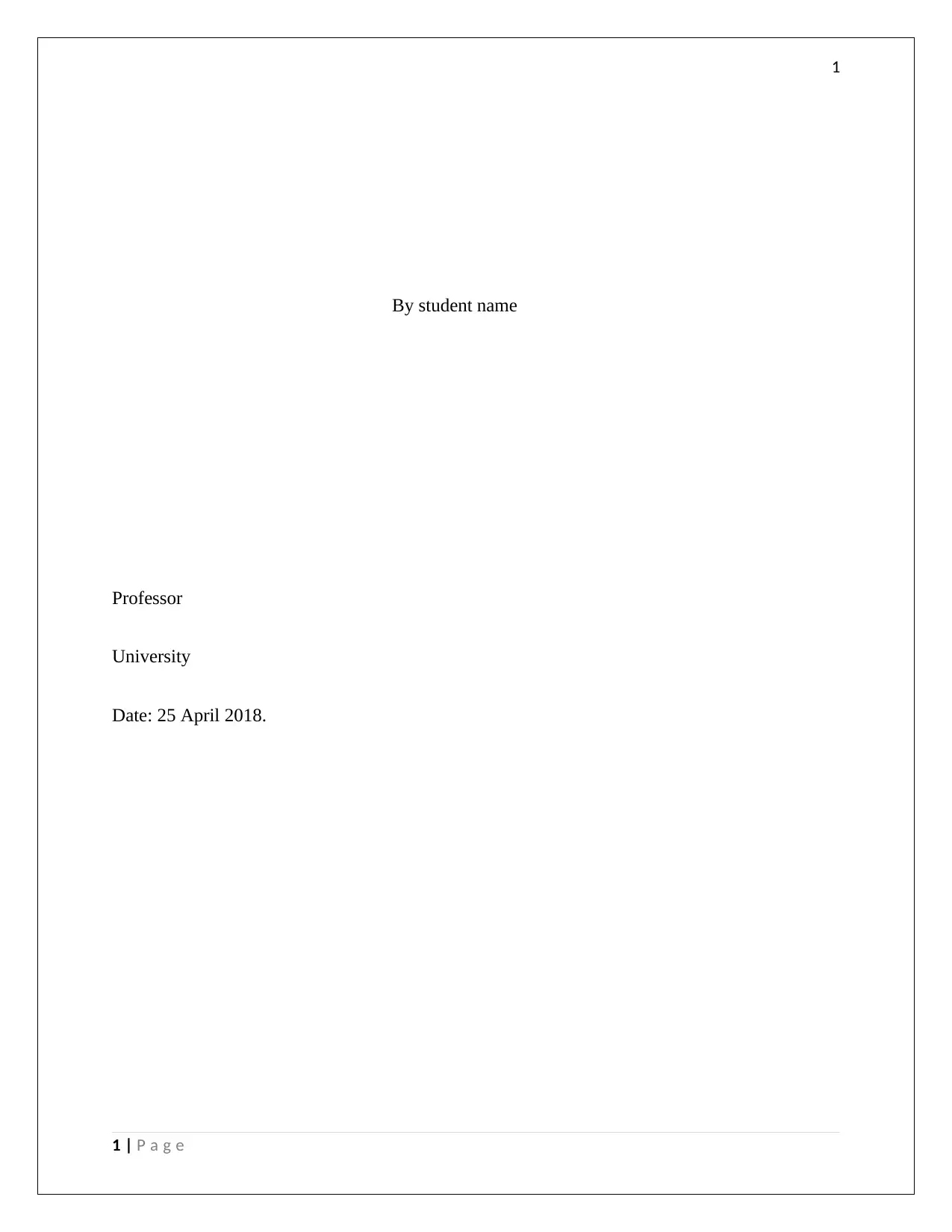
1
By student name
Professor
University
Date: 25 April 2018.
1 | P a g e
By student name
Professor
University
Date: 25 April 2018.
1 | P a g e
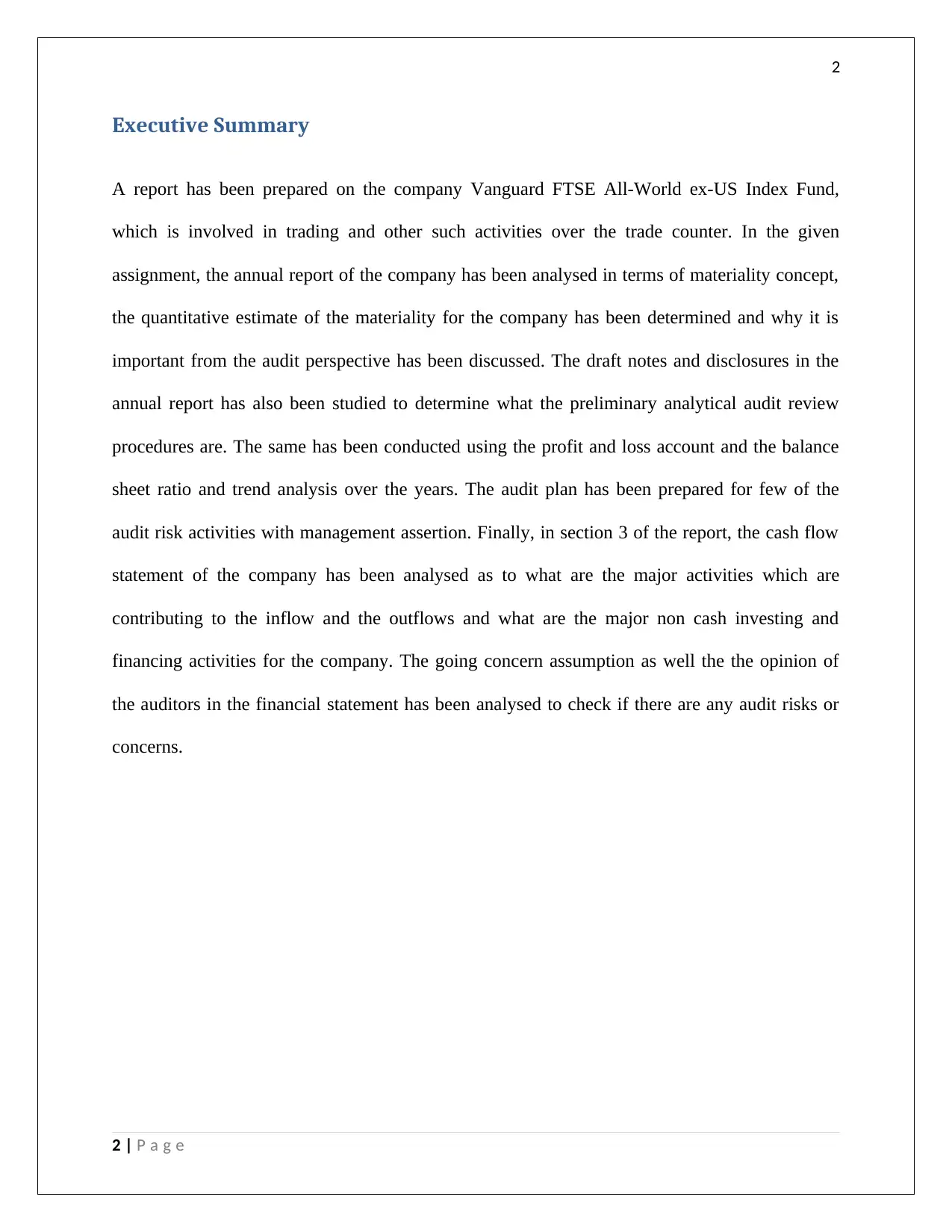
2
Executive Summary
A report has been prepared on the company Vanguard FTSE All-World ex-US Index Fund,
which is involved in trading and other such activities over the trade counter. In the given
assignment, the annual report of the company has been analysed in terms of materiality concept,
the quantitative estimate of the materiality for the company has been determined and why it is
important from the audit perspective has been discussed. The draft notes and disclosures in the
annual report has also been studied to determine what the preliminary analytical audit review
procedures are. The same has been conducted using the profit and loss account and the balance
sheet ratio and trend analysis over the years. The audit plan has been prepared for few of the
audit risk activities with management assertion. Finally, in section 3 of the report, the cash flow
statement of the company has been analysed as to what are the major activities which are
contributing to the inflow and the outflows and what are the major non cash investing and
financing activities for the company. The going concern assumption as well the the opinion of
the auditors in the financial statement has been analysed to check if there are any audit risks or
concerns.
2 | P a g e
Executive Summary
A report has been prepared on the company Vanguard FTSE All-World ex-US Index Fund,
which is involved in trading and other such activities over the trade counter. In the given
assignment, the annual report of the company has been analysed in terms of materiality concept,
the quantitative estimate of the materiality for the company has been determined and why it is
important from the audit perspective has been discussed. The draft notes and disclosures in the
annual report has also been studied to determine what the preliminary analytical audit review
procedures are. The same has been conducted using the profit and loss account and the balance
sheet ratio and trend analysis over the years. The audit plan has been prepared for few of the
audit risk activities with management assertion. Finally, in section 3 of the report, the cash flow
statement of the company has been analysed as to what are the major activities which are
contributing to the inflow and the outflows and what are the major non cash investing and
financing activities for the company. The going concern assumption as well the the opinion of
the auditors in the financial statement has been analysed to check if there are any audit risks or
concerns.
2 | P a g e
⊘ This is a preview!⊘
Do you want full access?
Subscribe today to unlock all pages.

Trusted by 1+ million students worldwide
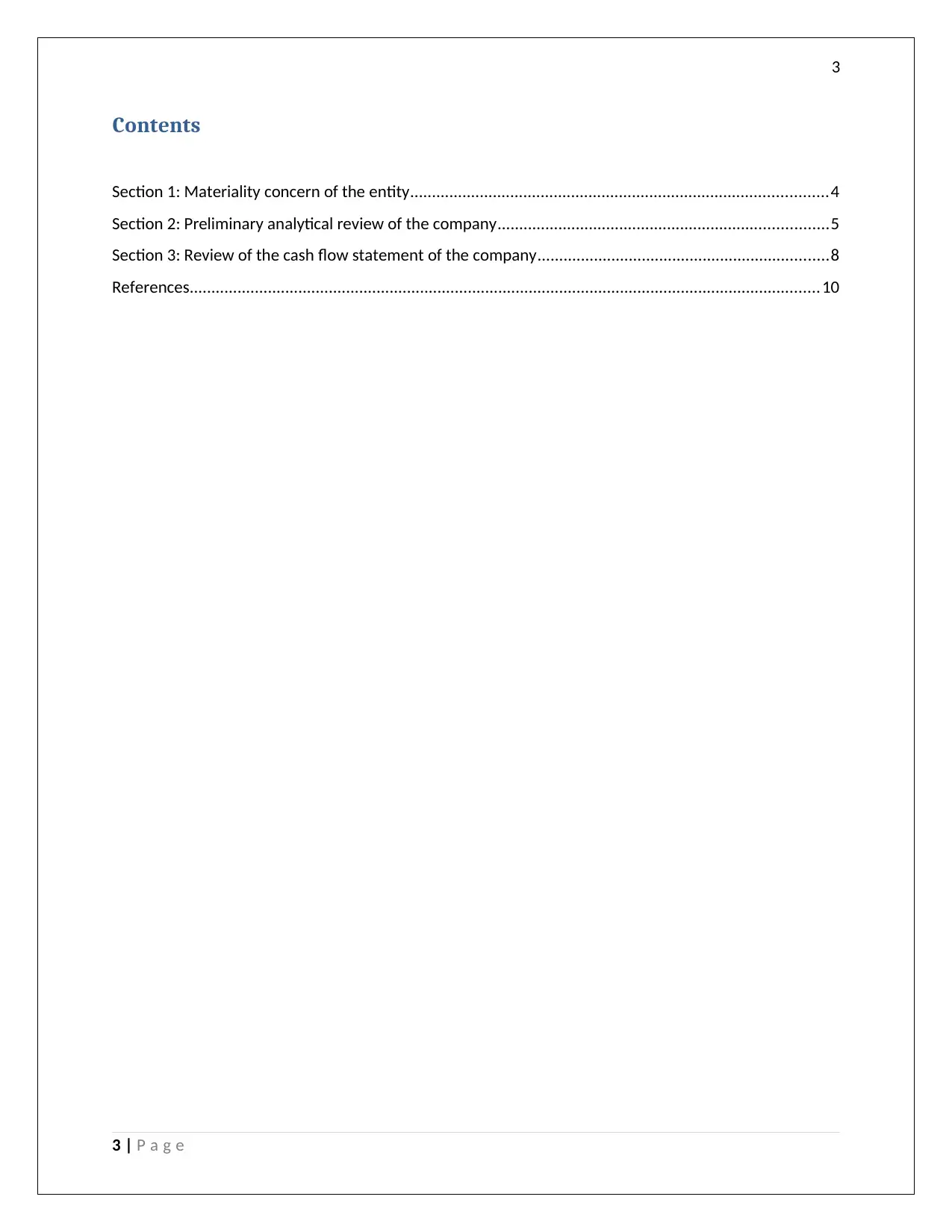
3
Contents
Section 1: Materiality concern of the entity................................................................................................4
Section 2: Preliminary analytical review of the company............................................................................5
Section 3: Review of the cash flow statement of the company...................................................................8
References.................................................................................................................................................10
3 | P a g e
Contents
Section 1: Materiality concern of the entity................................................................................................4
Section 2: Preliminary analytical review of the company............................................................................5
Section 3: Review of the cash flow statement of the company...................................................................8
References.................................................................................................................................................10
3 | P a g e
Paraphrase This Document
Need a fresh take? Get an instant paraphrase of this document with our AI Paraphraser
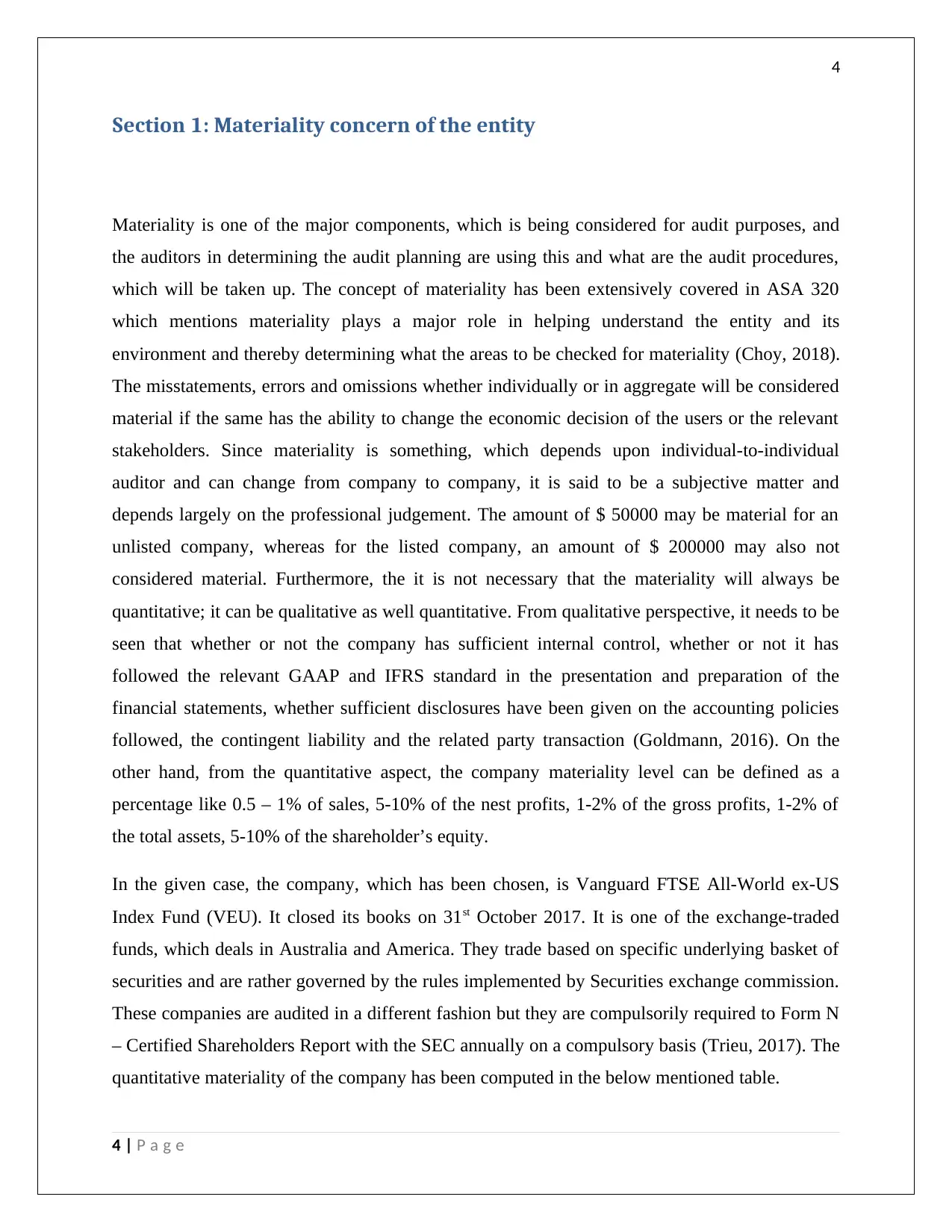
4
Section 1: Materiality concern of the entity
Materiality is one of the major components, which is being considered for audit purposes, and
the auditors in determining the audit planning are using this and what are the audit procedures,
which will be taken up. The concept of materiality has been extensively covered in ASA 320
which mentions materiality plays a major role in helping understand the entity and its
environment and thereby determining what the areas to be checked for materiality (Choy, 2018).
The misstatements, errors and omissions whether individually or in aggregate will be considered
material if the same has the ability to change the economic decision of the users or the relevant
stakeholders. Since materiality is something, which depends upon individual-to-individual
auditor and can change from company to company, it is said to be a subjective matter and
depends largely on the professional judgement. The amount of $ 50000 may be material for an
unlisted company, whereas for the listed company, an amount of $ 200000 may also not
considered material. Furthermore, the it is not necessary that the materiality will always be
quantitative; it can be qualitative as well quantitative. From qualitative perspective, it needs to be
seen that whether or not the company has sufficient internal control, whether or not it has
followed the relevant GAAP and IFRS standard in the presentation and preparation of the
financial statements, whether sufficient disclosures have been given on the accounting policies
followed, the contingent liability and the related party transaction (Goldmann, 2016). On the
other hand, from the quantitative aspect, the company materiality level can be defined as a
percentage like 0.5 – 1% of sales, 5-10% of the nest profits, 1-2% of the gross profits, 1-2% of
the total assets, 5-10% of the shareholder’s equity.
In the given case, the company, which has been chosen, is Vanguard FTSE All-World ex-US
Index Fund (VEU). It closed its books on 31st October 2017. It is one of the exchange-traded
funds, which deals in Australia and America. They trade based on specific underlying basket of
securities and are rather governed by the rules implemented by Securities exchange commission.
These companies are audited in a different fashion but they are compulsorily required to Form N
– Certified Shareholders Report with the SEC annually on a compulsory basis (Trieu, 2017). The
quantitative materiality of the company has been computed in the below mentioned table.
4 | P a g e
Section 1: Materiality concern of the entity
Materiality is one of the major components, which is being considered for audit purposes, and
the auditors in determining the audit planning are using this and what are the audit procedures,
which will be taken up. The concept of materiality has been extensively covered in ASA 320
which mentions materiality plays a major role in helping understand the entity and its
environment and thereby determining what the areas to be checked for materiality (Choy, 2018).
The misstatements, errors and omissions whether individually or in aggregate will be considered
material if the same has the ability to change the economic decision of the users or the relevant
stakeholders. Since materiality is something, which depends upon individual-to-individual
auditor and can change from company to company, it is said to be a subjective matter and
depends largely on the professional judgement. The amount of $ 50000 may be material for an
unlisted company, whereas for the listed company, an amount of $ 200000 may also not
considered material. Furthermore, the it is not necessary that the materiality will always be
quantitative; it can be qualitative as well quantitative. From qualitative perspective, it needs to be
seen that whether or not the company has sufficient internal control, whether or not it has
followed the relevant GAAP and IFRS standard in the presentation and preparation of the
financial statements, whether sufficient disclosures have been given on the accounting policies
followed, the contingent liability and the related party transaction (Goldmann, 2016). On the
other hand, from the quantitative aspect, the company materiality level can be defined as a
percentage like 0.5 – 1% of sales, 5-10% of the nest profits, 1-2% of the gross profits, 1-2% of
the total assets, 5-10% of the shareholder’s equity.
In the given case, the company, which has been chosen, is Vanguard FTSE All-World ex-US
Index Fund (VEU). It closed its books on 31st October 2017. It is one of the exchange-traded
funds, which deals in Australia and America. They trade based on specific underlying basket of
securities and are rather governed by the rules implemented by Securities exchange commission.
These companies are audited in a different fashion but they are compulsorily required to Form N
– Certified Shareholders Report with the SEC annually on a compulsory basis (Trieu, 2017). The
quantitative materiality of the company has been computed in the below mentioned table.
4 | P a g e
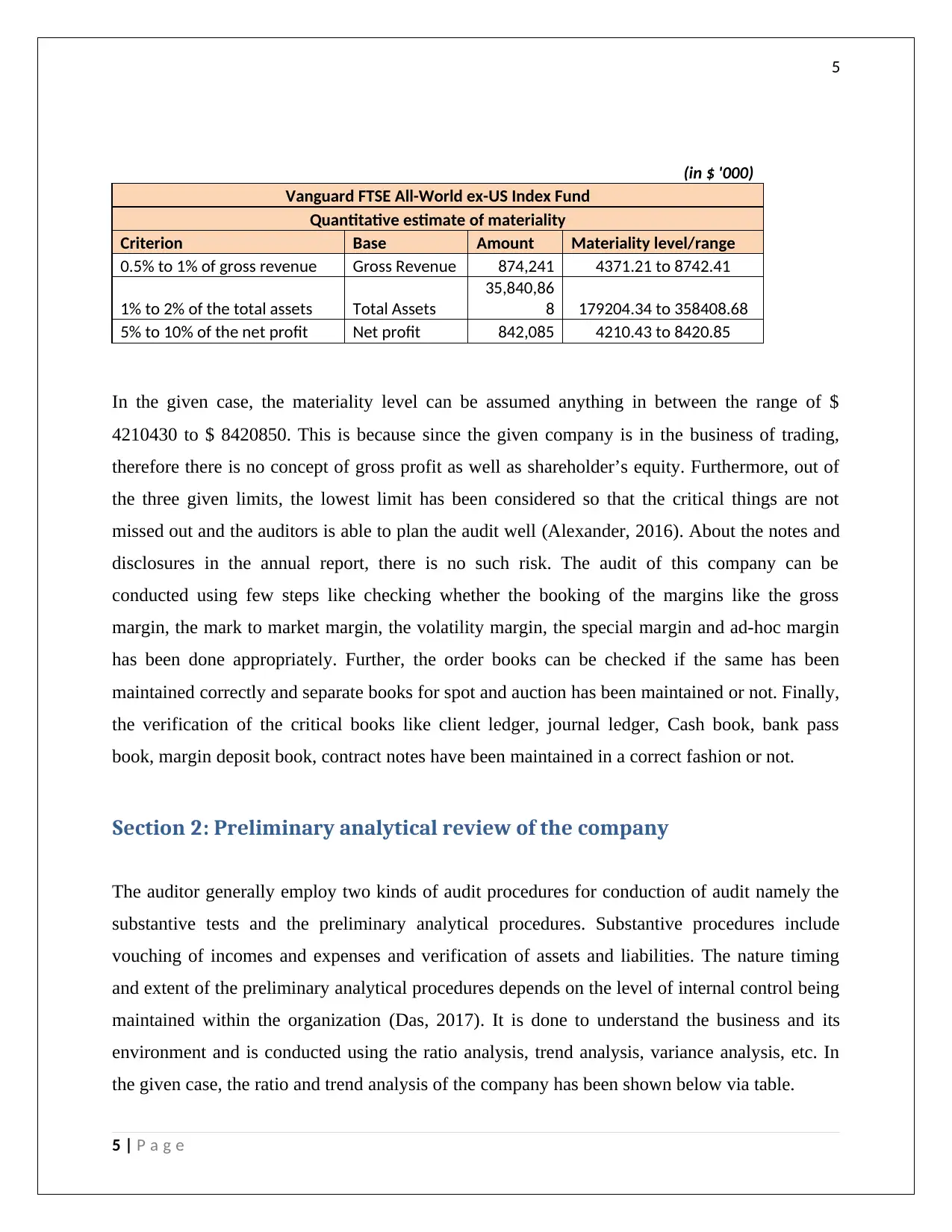
5
(in $ '000)
Vanguard FTSE All-World ex-US Index Fund
Quantitative estimate of materiality
Criterion Base Amount Materiality level/range
0.5% to 1% of gross revenue Gross Revenue 874,241 4371.21 to 8742.41
1% to 2% of the total assets Total Assets
35,840,86
8 179204.34 to 358408.68
5% to 10% of the net profit Net profit 842,085 4210.43 to 8420.85
In the given case, the materiality level can be assumed anything in between the range of $
4210430 to $ 8420850. This is because since the given company is in the business of trading,
therefore there is no concept of gross profit as well as shareholder’s equity. Furthermore, out of
the three given limits, the lowest limit has been considered so that the critical things are not
missed out and the auditors is able to plan the audit well (Alexander, 2016). About the notes and
disclosures in the annual report, there is no such risk. The audit of this company can be
conducted using few steps like checking whether the booking of the margins like the gross
margin, the mark to market margin, the volatility margin, the special margin and ad-hoc margin
has been done appropriately. Further, the order books can be checked if the same has been
maintained correctly and separate books for spot and auction has been maintained or not. Finally,
the verification of the critical books like client ledger, journal ledger, Cash book, bank pass
book, margin deposit book, contract notes have been maintained in a correct fashion or not.
Section 2: Preliminary analytical review of the company
The auditor generally employ two kinds of audit procedures for conduction of audit namely the
substantive tests and the preliminary analytical procedures. Substantive procedures include
vouching of incomes and expenses and verification of assets and liabilities. The nature timing
and extent of the preliminary analytical procedures depends on the level of internal control being
maintained within the organization (Das, 2017). It is done to understand the business and its
environment and is conducted using the ratio analysis, trend analysis, variance analysis, etc. In
the given case, the ratio and trend analysis of the company has been shown below via table.
5 | P a g e
(in $ '000)
Vanguard FTSE All-World ex-US Index Fund
Quantitative estimate of materiality
Criterion Base Amount Materiality level/range
0.5% to 1% of gross revenue Gross Revenue 874,241 4371.21 to 8742.41
1% to 2% of the total assets Total Assets
35,840,86
8 179204.34 to 358408.68
5% to 10% of the net profit Net profit 842,085 4210.43 to 8420.85
In the given case, the materiality level can be assumed anything in between the range of $
4210430 to $ 8420850. This is because since the given company is in the business of trading,
therefore there is no concept of gross profit as well as shareholder’s equity. Furthermore, out of
the three given limits, the lowest limit has been considered so that the critical things are not
missed out and the auditors is able to plan the audit well (Alexander, 2016). About the notes and
disclosures in the annual report, there is no such risk. The audit of this company can be
conducted using few steps like checking whether the booking of the margins like the gross
margin, the mark to market margin, the volatility margin, the special margin and ad-hoc margin
has been done appropriately. Further, the order books can be checked if the same has been
maintained correctly and separate books for spot and auction has been maintained or not. Finally,
the verification of the critical books like client ledger, journal ledger, Cash book, bank pass
book, margin deposit book, contract notes have been maintained in a correct fashion or not.
Section 2: Preliminary analytical review of the company
The auditor generally employ two kinds of audit procedures for conduction of audit namely the
substantive tests and the preliminary analytical procedures. Substantive procedures include
vouching of incomes and expenses and verification of assets and liabilities. The nature timing
and extent of the preliminary analytical procedures depends on the level of internal control being
maintained within the organization (Das, 2017). It is done to understand the business and its
environment and is conducted using the ratio analysis, trend analysis, variance analysis, etc. In
the given case, the ratio and trend analysis of the company has been shown below via table.
5 | P a g e
⊘ This is a preview!⊘
Do you want full access?
Subscribe today to unlock all pages.

Trusted by 1+ million students worldwide
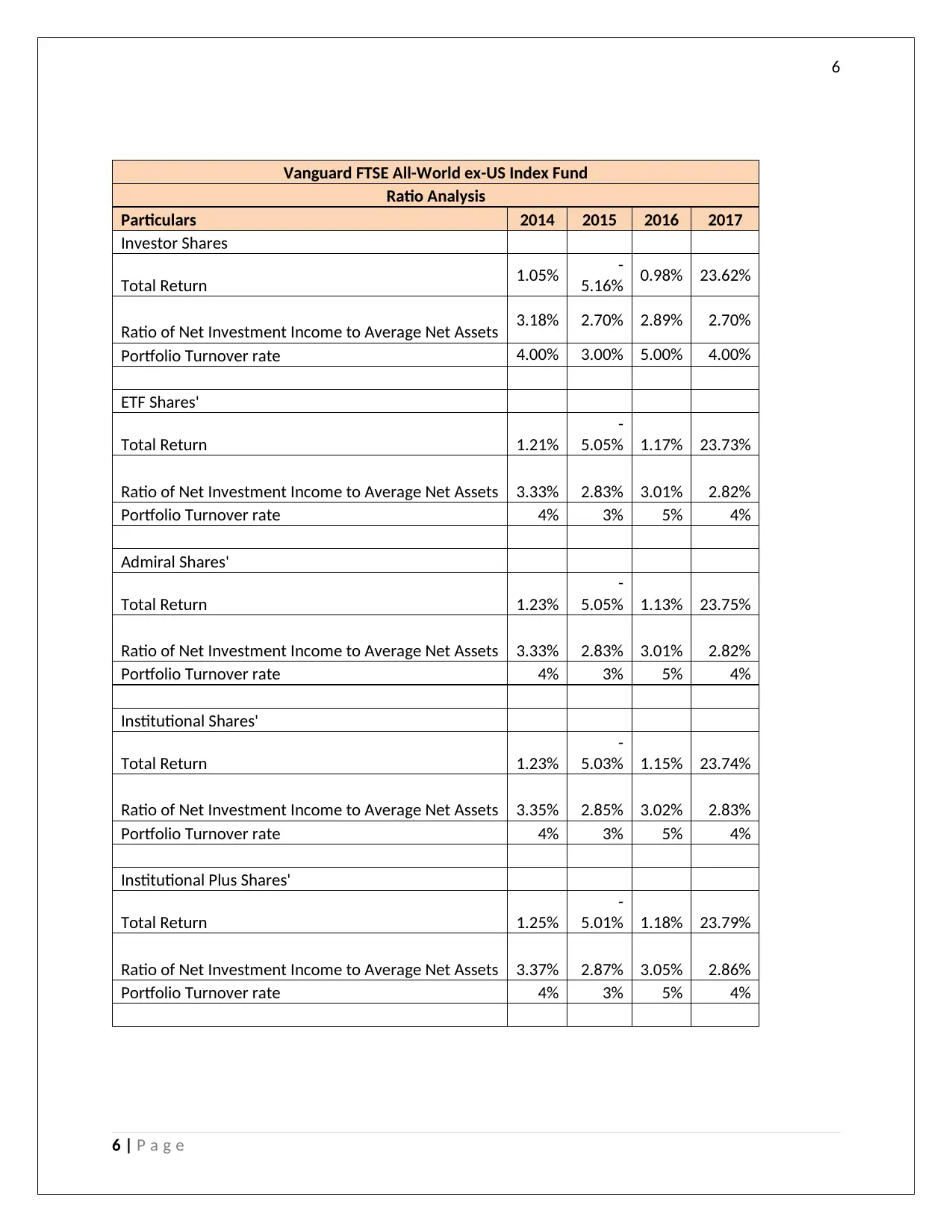
6
Vanguard FTSE All-World ex-US Index Fund
Ratio Analysis
Particulars 2014 2015 2016 2017
Investor Shares
Total Return 1.05% -
5.16% 0.98% 23.62%
Ratio of Net Investment Income to Average Net Assets 3.18% 2.70% 2.89% 2.70%
Portfolio Turnover rate 4.00% 3.00% 5.00% 4.00%
ETF Shares'
Total Return 1.21%
-
5.05% 1.17% 23.73%
Ratio of Net Investment Income to Average Net Assets 3.33% 2.83% 3.01% 2.82%
Portfolio Turnover rate 4% 3% 5% 4%
Admiral Shares'
Total Return 1.23%
-
5.05% 1.13% 23.75%
Ratio of Net Investment Income to Average Net Assets 3.33% 2.83% 3.01% 2.82%
Portfolio Turnover rate 4% 3% 5% 4%
Institutional Shares'
Total Return 1.23%
-
5.03% 1.15% 23.74%
Ratio of Net Investment Income to Average Net Assets 3.35% 2.85% 3.02% 2.83%
Portfolio Turnover rate 4% 3% 5% 4%
Institutional Plus Shares'
Total Return 1.25%
-
5.01% 1.18% 23.79%
Ratio of Net Investment Income to Average Net Assets 3.37% 2.87% 3.05% 2.86%
Portfolio Turnover rate 4% 3% 5% 4%
6 | P a g e
Vanguard FTSE All-World ex-US Index Fund
Ratio Analysis
Particulars 2014 2015 2016 2017
Investor Shares
Total Return 1.05% -
5.16% 0.98% 23.62%
Ratio of Net Investment Income to Average Net Assets 3.18% 2.70% 2.89% 2.70%
Portfolio Turnover rate 4.00% 3.00% 5.00% 4.00%
ETF Shares'
Total Return 1.21%
-
5.05% 1.17% 23.73%
Ratio of Net Investment Income to Average Net Assets 3.33% 2.83% 3.01% 2.82%
Portfolio Turnover rate 4% 3% 5% 4%
Admiral Shares'
Total Return 1.23%
-
5.05% 1.13% 23.75%
Ratio of Net Investment Income to Average Net Assets 3.33% 2.83% 3.01% 2.82%
Portfolio Turnover rate 4% 3% 5% 4%
Institutional Shares'
Total Return 1.23%
-
5.03% 1.15% 23.74%
Ratio of Net Investment Income to Average Net Assets 3.35% 2.85% 3.02% 2.83%
Portfolio Turnover rate 4% 3% 5% 4%
Institutional Plus Shares'
Total Return 1.25%
-
5.01% 1.18% 23.79%
Ratio of Net Investment Income to Average Net Assets 3.37% 2.87% 3.05% 2.86%
Portfolio Turnover rate 4% 3% 5% 4%
6 | P a g e
Paraphrase This Document
Need a fresh take? Get an instant paraphrase of this document with our AI Paraphraser
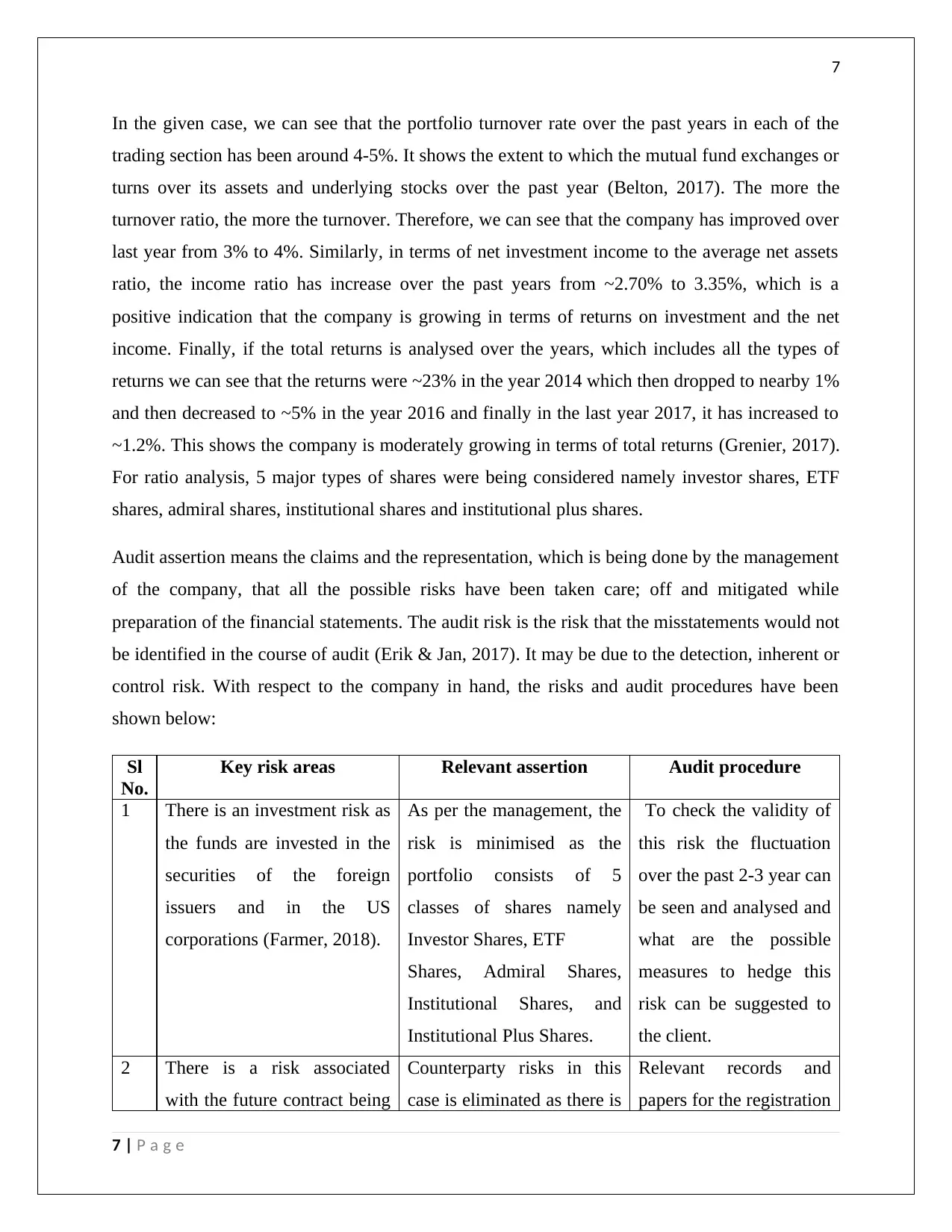
7
In the given case, we can see that the portfolio turnover rate over the past years in each of the
trading section has been around 4-5%. It shows the extent to which the mutual fund exchanges or
turns over its assets and underlying stocks over the past year (Belton, 2017). The more the
turnover ratio, the more the turnover. Therefore, we can see that the company has improved over
last year from 3% to 4%. Similarly, in terms of net investment income to the average net assets
ratio, the income ratio has increase over the past years from ~2.70% to 3.35%, which is a
positive indication that the company is growing in terms of returns on investment and the net
income. Finally, if the total returns is analysed over the years, which includes all the types of
returns we can see that the returns were ~23% in the year 2014 which then dropped to nearby 1%
and then decreased to ~5% in the year 2016 and finally in the last year 2017, it has increased to
~1.2%. This shows the company is moderately growing in terms of total returns (Grenier, 2017).
For ratio analysis, 5 major types of shares were being considered namely investor shares, ETF
shares, admiral shares, institutional shares and institutional plus shares.
Audit assertion means the claims and the representation, which is being done by the management
of the company, that all the possible risks have been taken care; off and mitigated while
preparation of the financial statements. The audit risk is the risk that the misstatements would not
be identified in the course of audit (Erik & Jan, 2017). It may be due to the detection, inherent or
control risk. With respect to the company in hand, the risks and audit procedures have been
shown below:
Sl
No.
Key risk areas Relevant assertion Audit procedure
1 There is an investment risk as
the funds are invested in the
securities of the foreign
issuers and in the US
corporations (Farmer, 2018).
As per the management, the
risk is minimised as the
portfolio consists of 5
classes of shares namely
Investor Shares, ETF
Shares, Admiral Shares,
Institutional Shares, and
Institutional Plus Shares.
To check the validity of
this risk the fluctuation
over the past 2-3 year can
be seen and analysed and
what are the possible
measures to hedge this
risk can be suggested to
the client.
2 There is a risk associated
with the future contract being
Counterparty risks in this
case is eliminated as there is
Relevant records and
papers for the registration
7 | P a g e
In the given case, we can see that the portfolio turnover rate over the past years in each of the
trading section has been around 4-5%. It shows the extent to which the mutual fund exchanges or
turns over its assets and underlying stocks over the past year (Belton, 2017). The more the
turnover ratio, the more the turnover. Therefore, we can see that the company has improved over
last year from 3% to 4%. Similarly, in terms of net investment income to the average net assets
ratio, the income ratio has increase over the past years from ~2.70% to 3.35%, which is a
positive indication that the company is growing in terms of returns on investment and the net
income. Finally, if the total returns is analysed over the years, which includes all the types of
returns we can see that the returns were ~23% in the year 2014 which then dropped to nearby 1%
and then decreased to ~5% in the year 2016 and finally in the last year 2017, it has increased to
~1.2%. This shows the company is moderately growing in terms of total returns (Grenier, 2017).
For ratio analysis, 5 major types of shares were being considered namely investor shares, ETF
shares, admiral shares, institutional shares and institutional plus shares.
Audit assertion means the claims and the representation, which is being done by the management
of the company, that all the possible risks have been taken care; off and mitigated while
preparation of the financial statements. The audit risk is the risk that the misstatements would not
be identified in the course of audit (Erik & Jan, 2017). It may be due to the detection, inherent or
control risk. With respect to the company in hand, the risks and audit procedures have been
shown below:
Sl
No.
Key risk areas Relevant assertion Audit procedure
1 There is an investment risk as
the funds are invested in the
securities of the foreign
issuers and in the US
corporations (Farmer, 2018).
As per the management, the
risk is minimised as the
portfolio consists of 5
classes of shares namely
Investor Shares, ETF
Shares, Admiral Shares,
Institutional Shares, and
Institutional Plus Shares.
To check the validity of
this risk the fluctuation
over the past 2-3 year can
be seen and analysed and
what are the possible
measures to hedge this
risk can be suggested to
the client.
2 There is a risk associated
with the future contract being
Counterparty risks in this
case is eliminated as there is
Relevant records and
papers for the registration
7 | P a g e
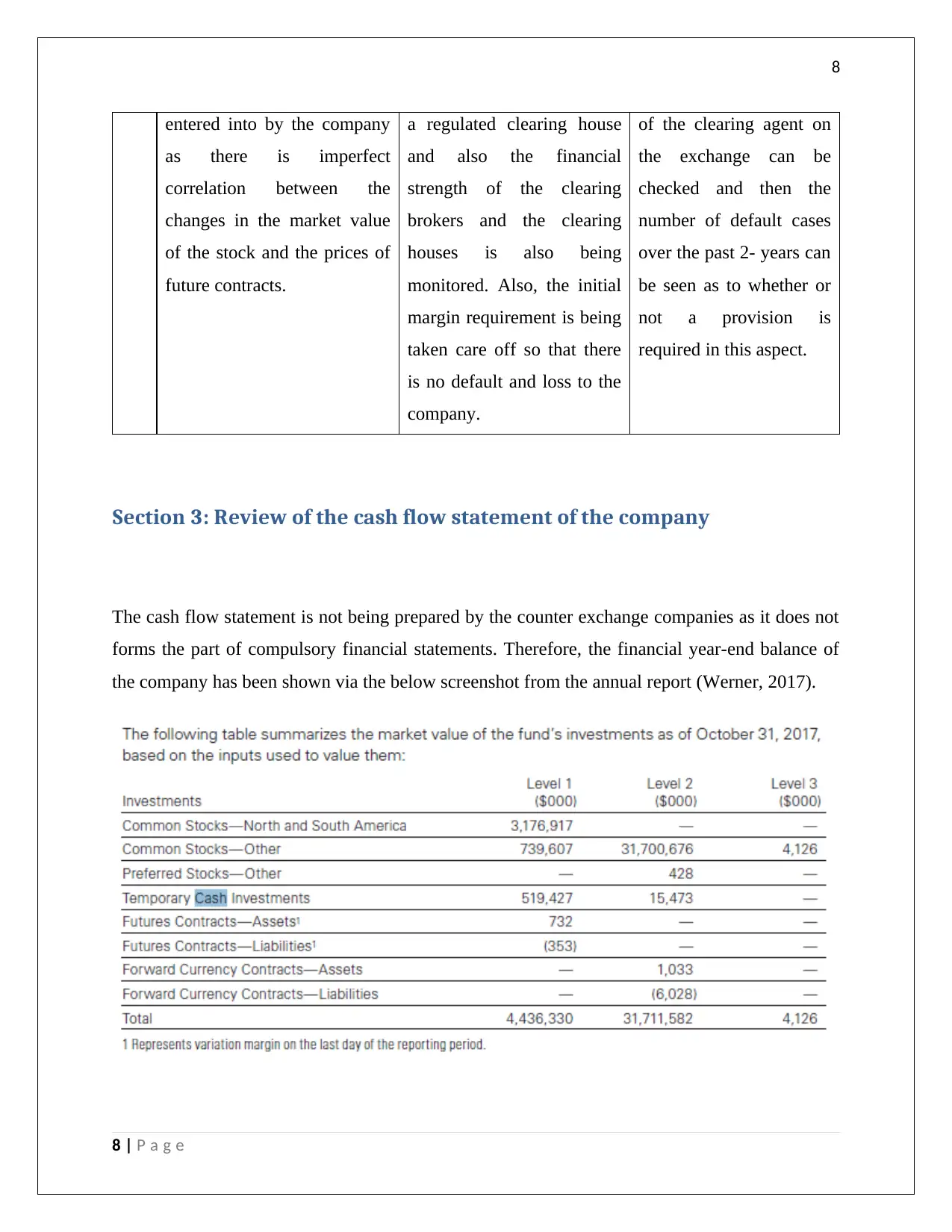
8
entered into by the company
as there is imperfect
correlation between the
changes in the market value
of the stock and the prices of
future contracts.
a regulated clearing house
and also the financial
strength of the clearing
brokers and the clearing
houses is also being
monitored. Also, the initial
margin requirement is being
taken care off so that there
is no default and loss to the
company.
of the clearing agent on
the exchange can be
checked and then the
number of default cases
over the past 2- years can
be seen as to whether or
not a provision is
required in this aspect.
Section 3: Review of the cash flow statement of the company
The cash flow statement is not being prepared by the counter exchange companies as it does not
forms the part of compulsory financial statements. Therefore, the financial year-end balance of
the company has been shown via the below screenshot from the annual report (Werner, 2017).
8 | P a g e
entered into by the company
as there is imperfect
correlation between the
changes in the market value
of the stock and the prices of
future contracts.
a regulated clearing house
and also the financial
strength of the clearing
brokers and the clearing
houses is also being
monitored. Also, the initial
margin requirement is being
taken care off so that there
is no default and loss to the
company.
of the clearing agent on
the exchange can be
checked and then the
number of default cases
over the past 2- years can
be seen as to whether or
not a provision is
required in this aspect.
Section 3: Review of the cash flow statement of the company
The cash flow statement is not being prepared by the counter exchange companies as it does not
forms the part of compulsory financial statements. Therefore, the financial year-end balance of
the company has been shown via the below screenshot from the annual report (Werner, 2017).
8 | P a g e
⊘ This is a preview!⊘
Do you want full access?
Subscribe today to unlock all pages.

Trusted by 1+ million students worldwide

9
From the above screenshot, we can see that the temporary cash investment of the company for
the year 2017 stands at a cumulative $ 534900. In case the major inflows and the outflows are
being analysed, we can see that the fund purchased $2,048,894,000 of investment securities and
sold $642,934,000 of investment securities during this given period, besides the temporary cash
investment (Mun, 2018). The company is an investment management company so there is no
financing and investing activity, everything falls within the ambit of the cash flow from
operating activities.
Considering the discussion above, it can be said that the company is making the going concern
assumption true, as there are no material errors, omissions and misstatements being reported in
the annual report. The audit procedures to check the risk and to mitigate the existing risk has
already been discussed in above sections (Jefferson, 2017).
The annual report has just been submitted to the SEC and the auditor of the company Price water
house Coopers has given a clear opinion that the accounts of the company has been prepared as
per the standards of the Public Company Accounting Oversight Board (United States) and that
all the relevant US accounting principles have been adhered to. In the disclosure section, it has
been mentioned that no material event or transaction has occurred beyond October 31, 2017 and
hence the same has not been reported (Sithole, Chandler, Abeysekera, & Paas, 2017).
9 | P a g e
From the above screenshot, we can see that the temporary cash investment of the company for
the year 2017 stands at a cumulative $ 534900. In case the major inflows and the outflows are
being analysed, we can see that the fund purchased $2,048,894,000 of investment securities and
sold $642,934,000 of investment securities during this given period, besides the temporary cash
investment (Mun, 2018). The company is an investment management company so there is no
financing and investing activity, everything falls within the ambit of the cash flow from
operating activities.
Considering the discussion above, it can be said that the company is making the going concern
assumption true, as there are no material errors, omissions and misstatements being reported in
the annual report. The audit procedures to check the risk and to mitigate the existing risk has
already been discussed in above sections (Jefferson, 2017).
The annual report has just been submitted to the SEC and the auditor of the company Price water
house Coopers has given a clear opinion that the accounts of the company has been prepared as
per the standards of the Public Company Accounting Oversight Board (United States) and that
all the relevant US accounting principles have been adhered to. In the disclosure section, it has
been mentioned that no material event or transaction has occurred beyond October 31, 2017 and
hence the same has not been reported (Sithole, Chandler, Abeysekera, & Paas, 2017).
9 | P a g e
Paraphrase This Document
Need a fresh take? Get an instant paraphrase of this document with our AI Paraphraser

10
References
Alexander, F. (2016). The Changing Face of Accountability. The Journal of Higher Education, 71(4), 411-
431.
Belton, P. (2017). Competitive Strategy: Creating and Sustaining Superior Performance. London: Macat
International ltd.
Choy, Y. K. (2018). Cost-benefit Analysis, Values, Wellbeing and Ethics: An Indigenous Worldview
Analysis. Ecological Economics, 145. Retrieved from
https://doi.org/10.1016/j.ecolecon.2017.08.005
Das, P. (2017). Financing Pattern and Utilization of Fixed Assets - A Study. Asian Journal of Social Science
Studies, 2(2), 10-17.
Erik, H., & Jan, B. (2017). Supply chain management and activity-based costing: Current status and
directions for the future. International Journal of Physical Distribution & Logistics Management,
47(8), 712-735.
Farmer, Y. (2018). Ethical Decision Making and Reputation Management in Public Relations. Journal of
Media Ethics, 1-12.
Goldmann, K. (2016). Financial Liquidity and Profitability Management in Practice of Polish Business.
Financial Environment and Business Development, 4, 103-112.
Grenier, J. (2017). Encouraging Professional Skepticism in the Industry Specialization Era. Journal of
Business Ethics, 142(2), 241-256.
Jefferson, M. (2017). Energy, Complexity and Wealth Maximization, R. Ayres. Springer, Switzerland .
Technological Forecasting and Social Change, 353-354.
Mun, K. a. (2018). A close look at the role of regulatory fit in consumers’ responses to unethical firms.
Sithole, S., Chandler, P., Abeysekera, I., & Paas, F. (2017). Benefits of guided self-management of
attention on learning accounting. Journal of Educational Psychology, 109(2), 220. Retrieved from
http://psycnet.apa.org/buy/2016-21263-001
Trieu, V. (2017). Getting value from Business Intelligence systems: A review and research agenda.
Decision Support Systems, 93, 111-124.
10 | P a g e
References
Alexander, F. (2016). The Changing Face of Accountability. The Journal of Higher Education, 71(4), 411-
431.
Belton, P. (2017). Competitive Strategy: Creating and Sustaining Superior Performance. London: Macat
International ltd.
Choy, Y. K. (2018). Cost-benefit Analysis, Values, Wellbeing and Ethics: An Indigenous Worldview
Analysis. Ecological Economics, 145. Retrieved from
https://doi.org/10.1016/j.ecolecon.2017.08.005
Das, P. (2017). Financing Pattern and Utilization of Fixed Assets - A Study. Asian Journal of Social Science
Studies, 2(2), 10-17.
Erik, H., & Jan, B. (2017). Supply chain management and activity-based costing: Current status and
directions for the future. International Journal of Physical Distribution & Logistics Management,
47(8), 712-735.
Farmer, Y. (2018). Ethical Decision Making and Reputation Management in Public Relations. Journal of
Media Ethics, 1-12.
Goldmann, K. (2016). Financial Liquidity and Profitability Management in Practice of Polish Business.
Financial Environment and Business Development, 4, 103-112.
Grenier, J. (2017). Encouraging Professional Skepticism in the Industry Specialization Era. Journal of
Business Ethics, 142(2), 241-256.
Jefferson, M. (2017). Energy, Complexity and Wealth Maximization, R. Ayres. Springer, Switzerland .
Technological Forecasting and Social Change, 353-354.
Mun, K. a. (2018). A close look at the role of regulatory fit in consumers’ responses to unethical firms.
Sithole, S., Chandler, P., Abeysekera, I., & Paas, F. (2017). Benefits of guided self-management of
attention on learning accounting. Journal of Educational Psychology, 109(2), 220. Retrieved from
http://psycnet.apa.org/buy/2016-21263-001
Trieu, V. (2017). Getting value from Business Intelligence systems: A review and research agenda.
Decision Support Systems, 93, 111-124.
10 | P a g e
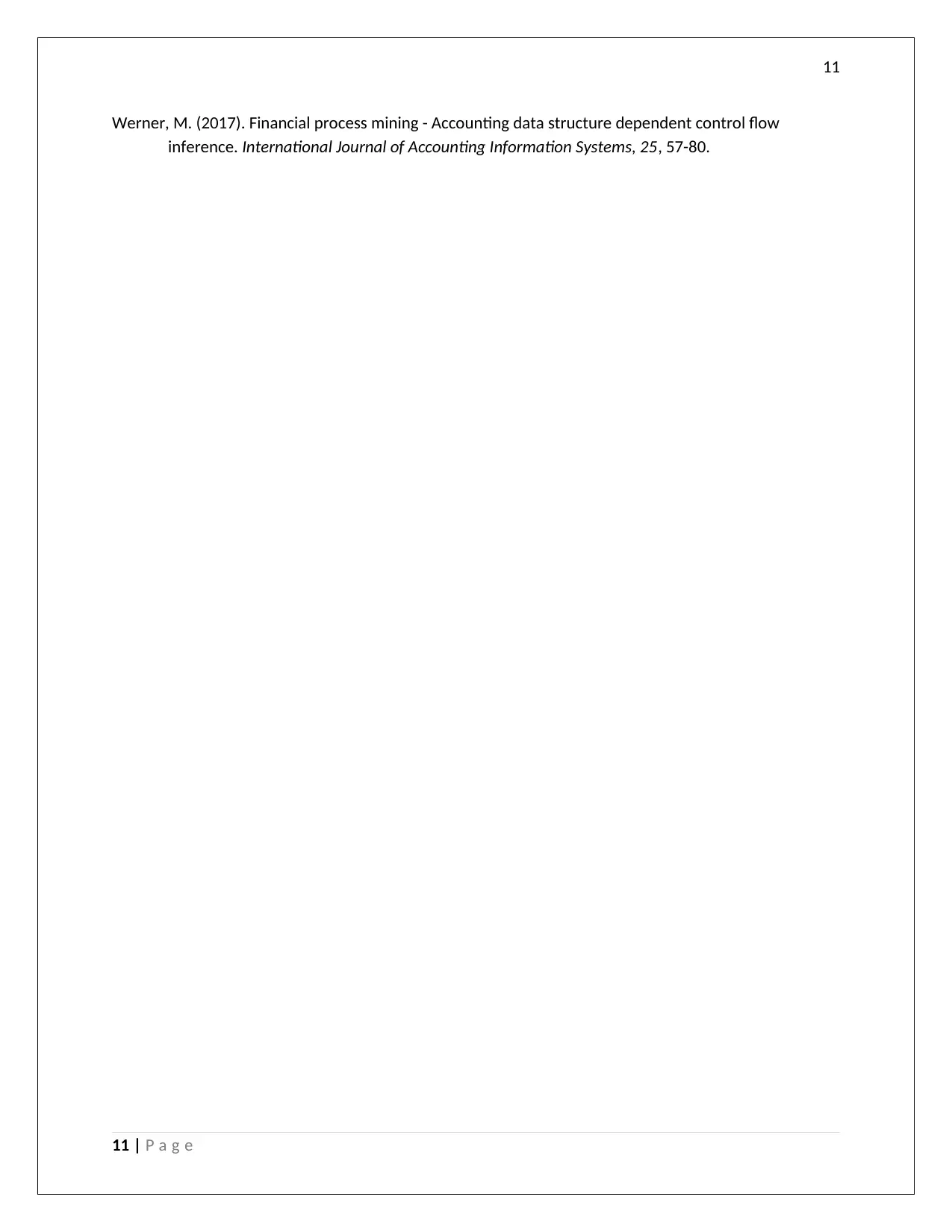
11
Werner, M. (2017). Financial process mining - Accounting data structure dependent control flow
inference. International Journal of Accounting Information Systems, 25, 57-80.
11 | P a g e
Werner, M. (2017). Financial process mining - Accounting data structure dependent control flow
inference. International Journal of Accounting Information Systems, 25, 57-80.
11 | P a g e
⊘ This is a preview!⊘
Do you want full access?
Subscribe today to unlock all pages.

Trusted by 1+ million students worldwide
1 out of 12
Related Documents
Your All-in-One AI-Powered Toolkit for Academic Success.
+13062052269
info@desklib.com
Available 24*7 on WhatsApp / Email
![[object Object]](/_next/static/media/star-bottom.7253800d.svg)
Unlock your academic potential
Copyright © 2020–2025 A2Z Services. All Rights Reserved. Developed and managed by ZUCOL.





